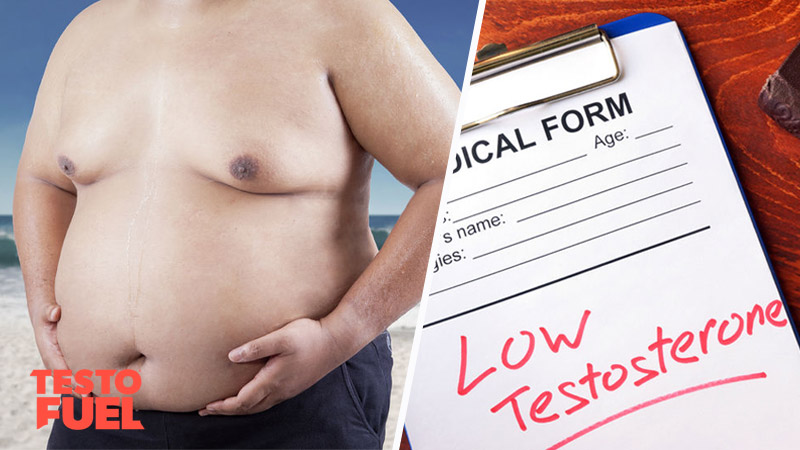TestoFuel Blog : Make Gains & Pack on the Muscle

Testosterone is the king of male hormones. When levels are high you’ll feel strong and authoritative. You ooze confidence and those around you know who’s boss.
Not only does it optimize your physical stature and muscular strength, it keeps you healthy too. And if that’s not enough, it helps to boost your libido and improve your sexual performance.
But when T levels start to drop you can suffer from range of side effects. In this article we talk about one such side effect – gynecomastia.
Here’s what we’ll cover:
Testosterone (T) is the primary male hormone. Released from the Leydig cells of your testes, it is responsible for controlling all things masculine. From your deep voice and your chiselled jaw, to your endurance, power and strength. It is both anabolic and androgenic.
After you reach puberty age, a part of your brain called the hypothalamus tells your testes to start to ramp up T production. It works a bit like a master switch that control and regulates testosterone production to make sure that you develop properly.
And it remains high all the way through your prime.
For a man between 18 and 30 years old, normal testosterone levels fall between 300 – 1000 ng.dL.
As you reach the age of thirty, your T production naturally begins to slow.
You lose around 1% of your free T each year, and by the age of 60, a large percentage of men are clinically hypogondal. That means that their hormone levels fall below the normal threshold – they have low T.
But it’s not just a condition for those who ageing. It’s a condition that is affecting more and more men earlier in life too. In fact in the US 1 in 4 men are now clinically hypogonodal.
If your testosterone levels drop, you can begin to lose all that makes you masculine.
You muscle mass will decrease and your overall athleticism will plummet. You’ll find it harder to maintain an erection and consequently your sexual performance and libido will become non-existent.
You’ll also start to develop body fat, particularly evident around your belly and chest. You begin to suffer from gynecomastia.
Gynecomastia or gyno refers to the enlargement of breast tissue in men. It is common in both teenage boys and older men but is becoming an increasing problem for many men in the modern world, regardless of age.
Often referred to as male breasts or man boobs as it gives the appearance of breast tissue similar to women, gynecomastia can be both embarrassing and painful. In the less forgiving media it is referred to as bitch tits.
Symptoms can vary from a small enlargement around the nipple to more prominent breast-like tissue.
There can be several causes of gyno, but it is often linked to an imbalance between testosterone and estrogen – the male and female hormones of the body.
It is thought to be caused by low testosterone and an increase in estrogen and around 85-90% of men with gyno also have high estrogen levels.
All men produce a small amount of estrogen.
As part of your natural hormonal profile, some of your testosterone is naturally converted to estrogen via a process called aromatization.
This is so testosterone levels can be regulated and don’t get too high. It also helps with a number of other processes too such as brain cell regulation and erection strength.
During puberty, testosterone levels increase massively compared to estrogen, but as you age your T levels begin to fall and estrogen creeps up through an increase in aromatization.
This can lead to too much estrogen in the body.
And what happens if estrogen levels get too high?
Those estrogen hormones bind to receptors in your chest and breast tissue starts to grow. You are particularly at risk if you are overweight or obese as fat cells store estrogen.
High levels of anabolic steroids can elevate levels of estrogen too. In fact, steroid abuse is one of the major causes of gynecomastia away from obesity.
Steroid-induced male breast tissue can occur in as little as one week. In some cases it may even be permanent.
Other than through steroid abuse, there is a wealth of research that suggests gyno a treatable condition.
The key is to focus on elevating testosterone and also blocking estrogen from accumulating in the bloodstream. This means attacking the condition at the root cause not just the symptoms.
A good place to start would be to try and lose body fat. There is a strong relationship between being overweight and excess breast tissue.
As your body fat comes down, your testosterone levels have more room to flourish – and this means lower estrogen and a decrease in gynecomastia.
Some studies have shown that weight loss can completely reverse the imbalance between circulating estrogens and reduced androgen binding [1].
There are a number of prescription drugs on offer that claim to treat gynecomastia. It is also possible to treat it with radiotherapy or surgical intervention.
The problem with these methods though is they don’t necessarily fix your testosterone levels and can just mask the overall issues.
Surgery is expensive and can carry high risk of side effects too such as post-operative complications, scarring and deformities. It is invasive and carries an inherent risk of infection and pain.
The easiest and best place to start is to get the problem under control naturally. This means focusing on nutrients that have been shown to elevate testosterone or put the brakes on aromatization.
Whereas prescription drugs come with a number of potential side effects, your body is more receptive to natural components than synthetic ones.
There are no side effects to high-quality, natural testosterone boosters.
There are a small number of nutrients can help you fight gynecomastia by directly elevating your testosterone levels.
Nutrients such as zinc, vitamin D and D-aspartic acid have all been found to boost androgen levels in comprehensive clinical trials. They are an inexpensive alternative to both prescription drugs and surgery.
Combined with effective weight loss exercise and diet, natural testosterone boosters provide you with all you need to improve your physique and regain your confidence.
Gynecomastia is an embarrassing and painful disorder caused by an imbalance between testosterone and estrogen.
There are a number of options you can take to reverse it. These include focusing on decreasing excess body fat as well as more riskier interventions such as prescription drugs and surgery.
We suggest that you focus your attention on natural ways to boost your testosterone in order to fix the root of the issues. That way you can be confident that your physique will improve without risking your health.
